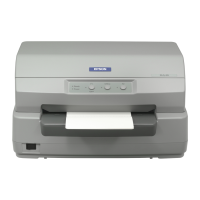
Do you have a question about the Epson PLQ-20 and is the answer not in the manual?
| Color | Yes |
|---|---|
| Character sets | ISO 8859-15, PC437, PC850, PC858 |
| Character pitch | 10, 12 cpi |
| Built-in barcodes | CODABAR (NW-7), EAN13, EAN8, Industrial 2/5, Interleaved 2/5, UPC-A, UPC-E |
| Maximum number of copies | 7 copies |
| Maximum print speed (LQ) | 144 cps |
| Maximum print speed (draft) | 432 cps |
| Maximum printing width (columns) | 94 |
| Needles | 24 |
| Fonts included | PR2: 4LQ & 2 Draft Bitmap, 8 Barcode, ESC/P: 9LQ & 1 Draft Bitmap, 4 Scalable typefaces, 8 Barcode |
| Print technology | Dot matrix |
| Connectivity technology | Wired |
| Print direction | Bi-directional |
| Ribbon life (black, LQ) | 5 million characters |
| Ribbon life (black, draft) | 10 million characters |
| Mean time between failures (MTBF) | 10000 h |
| Standard interfaces | Parallel, RS-232, USB 2.0 |
| Certification | 73/23 EEC, EN60950, EN55022 (CISPR pub.22) class B, AS/NZS 3548 class B, EN55022 class B, EN61000-3-2, EN61000-3-3, EN55024 |
| Product color | Gray |
| Country of origin | Indonesia |
| Page description languages | Epson ESC/P2, PPDS |
| Sound pressure level (printing) | 53 dB |
| AC input voltage | 220 - 240 V |
| AC input frequency | 50 - 60 Hz |
| Power consumption (standby) | 8 W |
| Power consumption (typical) | 60 W |
| Windows operating systems supported | Windows 2000, Windows 7, Windows 8, Windows Vista, Windows XP |
| Paper tray media types | Envelopes |
| Pallet width | 1200 mm |
| Pallet height | 1000 mm |
| Pallet length (UK) | 2040 mm |
| Quantity per pallet | 28 pc(s) |
| Quantity per pallet (UK) | 42 pc(s) |
| Quantity per pallet layer | 4 pc(s) |
| Harmonized System (HS) code | 84433210 |
| Quantity per pallet layer (UK) | 6 pc(s) |
| Package depth | 460 mm |
| Package width | 380 mm |
| Package height | 270 mm |
| Package weight | 9060 g |
| Quantity per pack | 1 pc(s) |
| Depth | 280 mm |
|---|---|
| Width | 384 mm |
| Height | 203 mm |
Details on items included in the printer box and initial unpacking steps.
Step-by-step instructions for physically assembling the printer components.
Guide on establishing the physical connection between the printer and computer.
Procedures for installing printer drivers and associated software for various OS.
Explains the meaning of warning symbols and notes for safe operation.
Comprehensive safety guidelines for printer setup and usage.
Instructions for loading and printing on passbooks.
Steps for loading single sheets of paper for printing.
How to adjust the vertical starting position of printouts.
Overview of printer driver and EPSON Status Monitor 3 functionality.
Guide to using the printer driver with specific Windows versions.
Guide to using the printer driver with later Windows versions.
Explanation of available printer driver settings and options.
Details on monitoring printer status and receiving alerts.
Instructions for sharing the printer on a network.
Procedure for stopping active print jobs.
Steps to remove printer drivers and related software.
Explanation of the printer's control panel buttons and indicator lights.
Describes functions accessed by holding buttons during power-on.
Overview of printer's default settings and how they control functions.
Detailed explanation of available default settings and options.
Step-by-step guide on how to modify printer's default settings.
Procedure to correct vertical misalignment in printouts.
General approach and tools for identifying printer issues.
How to use panel lights and beeps to identify errors.
Common printer problems and their corresponding solutions.
Troubleshooting steps specifically for USB connection issues.
Instructions for removing jammed paper from the printer.
Information on how to get help from Epson support services.
Information about replacing the printer's ribbon cartridge.
Step-by-step guide for replacing the ribbon cartridge.
Details on assembling and installing the optional roll paper holder.
Steps for loading paper using the roll paper holder.
Instructions for installing and using a network print server.
Diagrams and labels for printer and ribbon cartridge components.
Technical specifications covering mechanical, electronic, and environmental aspects.
Details on the printer's physical dimensions and printing capabilities.
Information on interfaces, buffer, fonts, and barcode support.
Specifications regarding voltage, frequency, and power consumption.
Operating and storage temperature and humidity guidelines.
Information on available paper types and printable areas.
Specifications for reading and writing data on magnetic stripes.
Reference to programming guide for printer commands.
List of safety and regulatory compliance standards for the printer.
Recommended procedures for cleaning the printer.
Guidelines for safely packing and transporting the printer.
